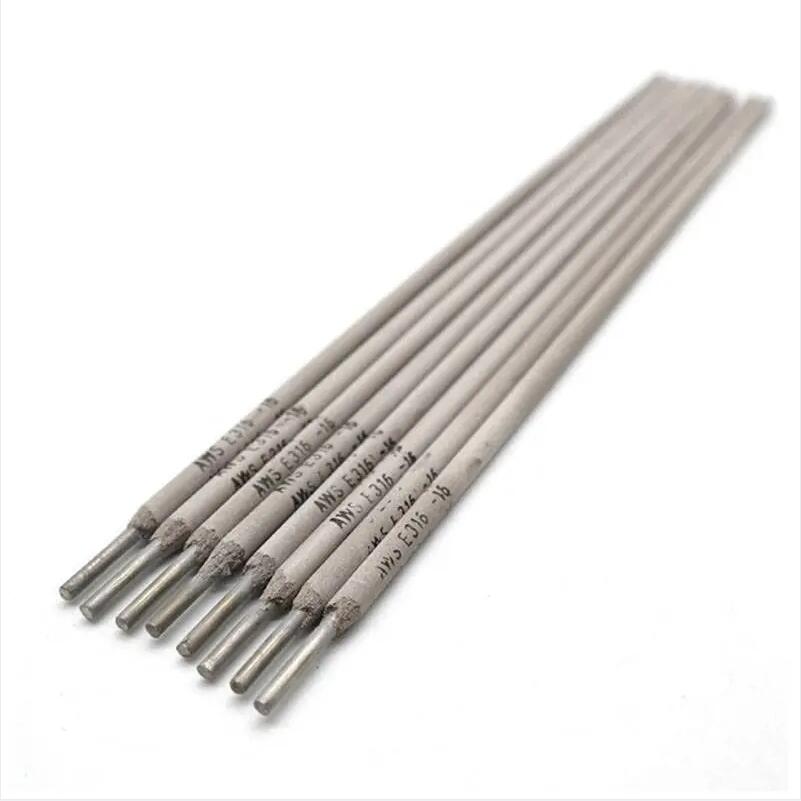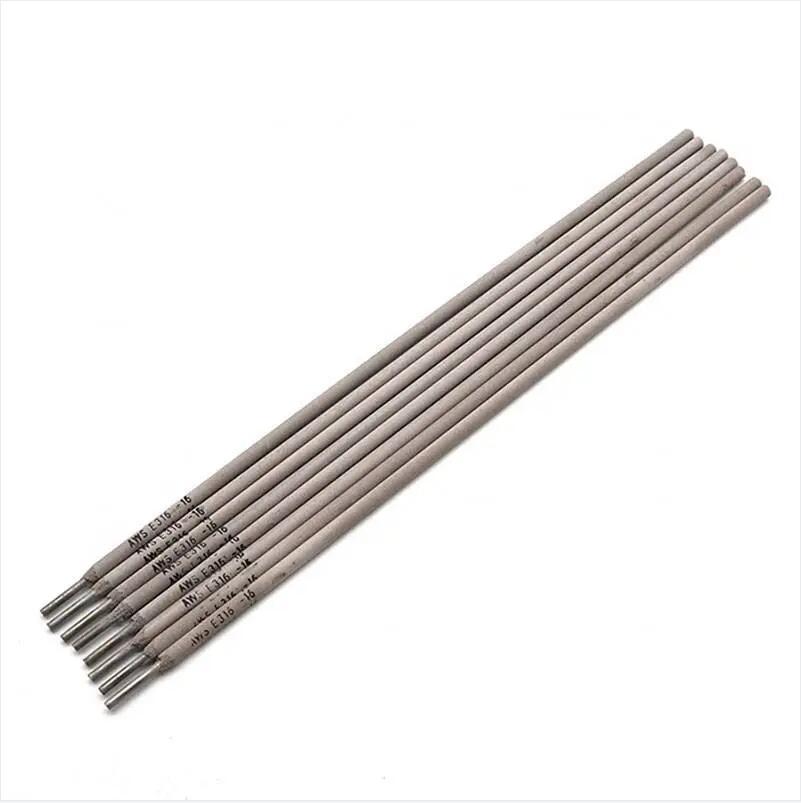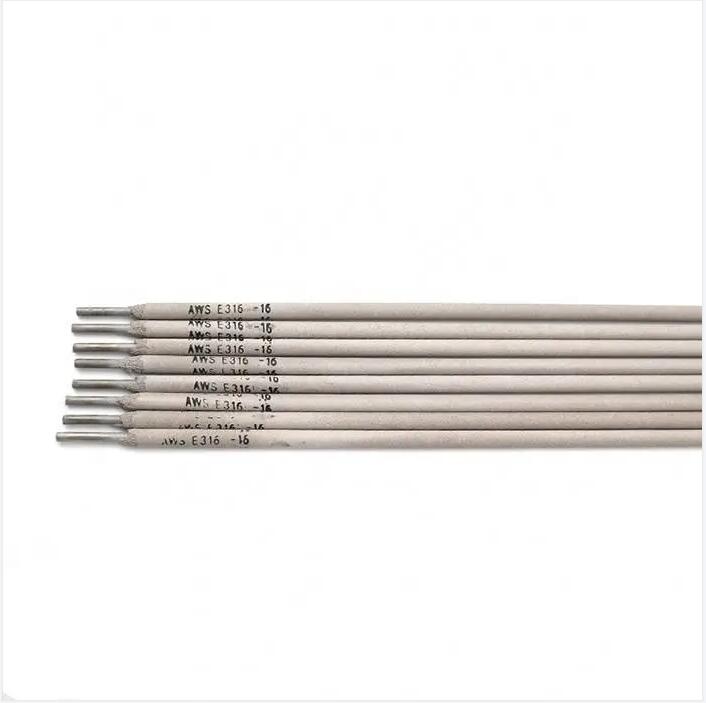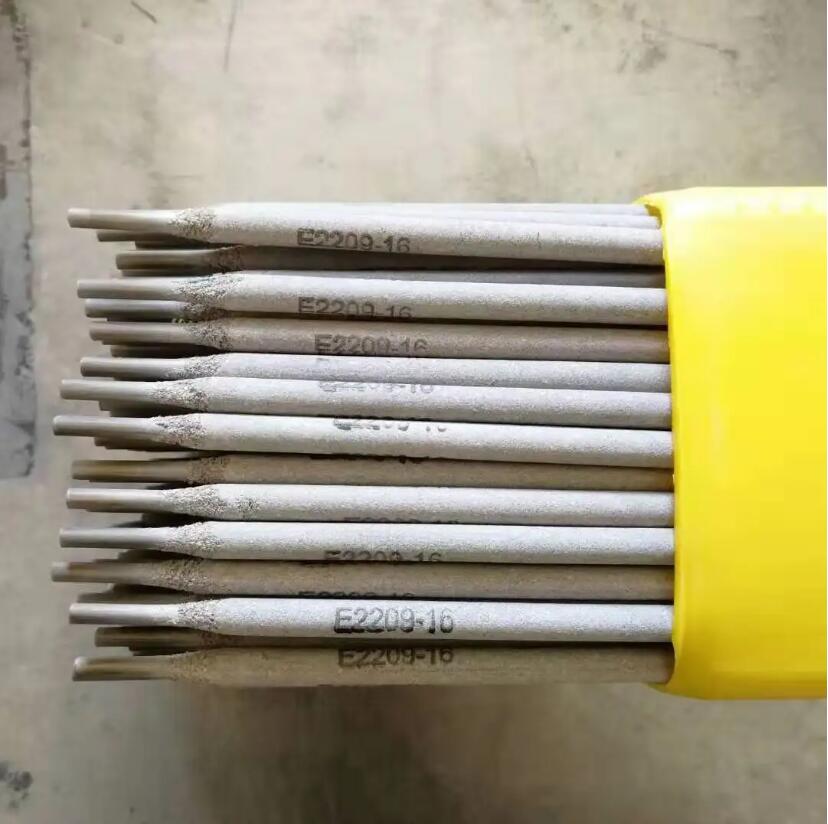Premium E316L Welding Rod for 316L Stainless Steel
Unlock superior welding performance for critical applications with the e316l welding rod. This guide provides an in-depth analysis of its technical specifications, manufacturing process, and industry advantages, establishing why the AWS E316-16(A202) is the premier choice for professionals demanding exceptional corrosion resistance and weld integrity.
Explore AWS E316-16(A202) NowNavigating the Industry: Why the e316l welding rod is More Crucial Than Ever
The global industrial landscape is experiencing a significant shift towards materials that offer longevity, reliability, and superior performance in harsh environments. According to a market analysis by Grand View Research, the stainless steel market is projected to grow substantially, driven by increasing demands from the petrochemical, chemical processing, and food & beverage industries. Within this trend, the need for high-quality welding consumables has skyrocketed. The e316l welding rod, specifically the 316l stainless steel welding rod, stands at the forefront of this demand. Its unique composition, enriched with molybdenum, provides unparalleled resistance to pitting and crevice corrosion, particularly in chloride-rich environments. This makes it an indispensable tool for fabricating and repairing equipment that handles corrosive fluids, from chemical reactors to marine hardware and pharmaceutical processing vats.
As regulations become stricter regarding environmental protection and operational safety (e.g., EPA and OSHA standards in the US), the integrity of welded joints is under more scrutiny than ever. A failed weld can lead to catastrophic leaks, costly downtime, and significant safety hazards. The "L" designation in E316L signifies low carbon content (typically ≤ 0.03%), which is a critical feature. This low carbon level minimizes the risk of carbide precipitation during welding, a phenomenon that can deplete chromium at the grain boundaries and make the weld susceptible to intergranular corrosion. By choosing a high-quality e316l welding rod like our AWS E316-16(A202), companies are not just buying a consumable; they are investing in the long-term structural integrity and compliance of their most critical assets.

Unpacking the Technicals: E316L Welding Rod Specifications
Understanding the technical parameters of an e316l welding rod is fundamental to achieving optimal welding results. These specifications, governed by standards like AWS A5.4, dictate the chemical composition of the deposited weld metal and its mechanical properties. These are not just numbers on a data sheet; they are the blueprint for a weld's performance under stress, temperature, and corrosive attack.
Table 1: Typical Weld Metal Chemical Composition (AWS A5.4 E316L-16)
| Element | AWS A5.4 Requirement (%) | Typical AWS E316-16(A202) Result (%) | Significance in Performance |
|---|---|---|---|
| Carbon (C) | 0.04 max | 0.03 | Low carbon ("L") prevents carbide precipitation, ensuring maximum corrosion resistance. |
| Manganese (Mn) | 0.5 - 2.5 | 1.75 | Acts as a deoxidizer and improves hot cracking resistance. |
| Silicon (Si) | 1.00 max | 0.45 | Improves weld pool fluidity and deoxidation. |
| Chromium (Cr) | 17.0 - 20.0 | 18.5 | The primary element for forming the passive, corrosion-resistant oxide layer. |
| Nickel (Ni) | 11.0 - 14.0 | 12.2 | Promotes an austenitic microstructure, enhancing ductility and toughness. |
| Molybdenum (Mo) | 2.0 - 3.0 | 2.4 | Critically enhances resistance to pitting and crevice corrosion, especially from chlorides. |
| Phosphorus (P) | 0.04 max | 0.025 | Kept low to minimize weld embrittlement and hot cracking. |
| Sulfur (S) | 0.03 max | 0.012 | Strictly controlled to prevent hot cracking and improve weld quality. |
Table 2: Mechanical Properties of As-Welded Deposit Metal
| Mechanical Property | AWS A5.4 Requirement | Typical AWS E316-16(A202) Performance |
|---|---|---|
| Tensile Strength | 520 MPa (75,000 psi) min | 590 MPa (85,500 psi) |
| Yield Strength | Not Specified | 460 MPa (66,700 psi) |
| Elongation in 2" | 30% min | 38% |
| Ferrite Number (FN) | 3 - 10 (Recommended) | 5 - 9 FN |
The data clearly shows that our AWS E316-16(A202) not only meets but comfortably exceeds the minimum requirements set by the American Welding Society. The higher tensile strength provides a stronger joint, while the excellent elongation percentage indicates superior ductility, meaning the weld can deform under stress without fracturing. The controlled Ferrite Number (FN) is a testament to our advanced manufacturing; it ensures a microstructure that is highly resistant to micro-fissuring and hot cracking during weld solidification.

From Raw Material to Flawless Weld: The Manufacturing Journey of AWS E316-16(A202)
The superior performance of an e316l welding rod is not accidental. It is the result of a meticulously controlled manufacturing process that transforms high-purity raw materials into a precision-engineered consumable. Our commitment to quality, certified by ISO 9001, is evident at every stage.
Visualizing the Process Flow:
High-purity 316L steel billet is drawn to precise diameters.
Rutile, carbonates, and alloys are precision-blended.
The flux is concentrically extruded onto the core wire under high pressure.
Rods are baked in calibrated ovens to remove moisture and activate binders.
Spectrometry, concentricity checks, and weld tests (as per ANSI/AWS standards).
Detailed Breakdown of Key Stages:
- Material Purity (Core Wire): The process begins with sourcing certified 316L stainless steel wire stock. We conduct incoming material inspection using X-ray fluorescence (XRF) to verify that the chemical composition, especially the low carbon and high molybdenum content, meets our stringent internal standards, which are tighter than the AWS baseline.
- Advanced Manufacturing (Flux Coating): The flux is the "brain" of the electrode. Our proprietary formula for the AWS E316-16(A202) includes rutile (TiO₂) for a stable arc and smooth bead, calcium carbonate (CaCO₃) for slag control, and carefully measured ferroalloys to compensate for any elemental loss across the arc. The coating is applied via a high-pressure extrusion process, ensuring perfect concentricity. A non-concentric coating can lead to arc blow and inconsistent weld deposits, a problem eliminated by our CNC-guided machinery.
- Rigorous Testing Standards: Quality is not just inspected; it's built-in. Every batch undergoes a battery of tests:
- Chemical Analysis: A sample from each batch is welded, and the resulting deposit is analyzed to confirm it meets AWS A5.4 chemical specifications.
- Mechanical Testing: All-weld-metal tensile tests and bend tests are performed to ensure the weld meets or exceeds strength and ductility requirements.
- Usability Testing: Certified welders test each batch for arc stability, slag detachability, bead appearance, and overall welder appeal.
- Extended Service Life: A weld created with our e316l welding rod is designed for maximum service life. The high molybdenum content and low carbon deposit provide exceptional resistance to general corrosion and, more importantly, localized pitting corrosion, which is the primary failure mode for stainless steel in industrial environments like petrochemical plants, water treatment facilities, and coastal infrastructure. This translates to fewer repairs, less downtime, and a lower total cost of ownership for the end-user.
Performance Visualized: AWS E316-16(A202) vs. The Competition
To demonstrate tangible value, we've benchmarked our AWS E316-16(A202) against standard competitor products in the market. The results highlight our focus on superior engineering and material quality.
Performance Benchmark: AWS E316-16(A202) vs. Generic E316L Rods
Chart 1: Comparative Tensile Strength (ksi)
Application Breakdown for E316L Electrodes
This chart represents the typical industry usage where the superior properties of a 316l stainless steel welding rod are mission-critical.
Chart 2: Typical Industry Application Share
Critical Applications & Technical Advantages
The theoretical specifications of a e316l welding rod come to life in its real-world applications. Its unique properties make it the go-to solution for a range of demanding sectors.

Petrochemical & Chemical Processing
Scenario: Welding pipes, pressure vessels, and reactors that handle sulfuric, phosphoric, and acetic acids.
Advantage: The 2-3% molybdenum content in the e316l welding rod provides robust defense against pitting corrosion caused by acidic and chloride-containing process fluids. The low carbon weld deposit prevents sensitization, ensuring long-term integrity even at elevated operating temperatures.
Food, Beverage & Pharmaceutical
Scenario: Fabricating and repairing stainless steel tanks, piping, and surfaces that require hygienic conditions and frequent cleaning with aggressive sanitizing agents.
Advantage: E316L welds offer a smooth, non-porous surface that is easy to clean and sanitize. Its superior corrosion resistance prevents metallic leaching into the product, ensuring compliance with FDA and other food safety standards.
Marine & Shipbuilding
Scenario: Welding boat railings, exhaust systems, and hardware exposed to saltwater spray and a highly corrosive marine atmosphere.
Advantage: Saltwater is rich in chlorides, the primary enemy of standard stainless steel. The 316l stainless steel welding rod creates welds that can withstand this constant attack, preventing the unsightly rust staining and structural failure common with lesser-grade materials.
Power Generation & Pollution Control
Scenario: Fabricating components for flue-gas desulfurization (FGD) systems and other pollution control equipment.
Advantage: The corrosive condensates found in these systems are highly acidic. The robust chemical resistance of the E316L weld metal ensures the longevity and reliability of this critical environmental equipment.
Tailored Solutions: Customization and Partnership
We understand that not all projects are the same. While our AWS E316-16(A202) is a versatile, high-performance product, we offer customization options for large-scale industrial partners. This demonstrates our commitment to being a solutions provider, not just a supplier.
- Diameter Variations: Beyond standard sizes (e.g., 2.5mm, 3.2mm, 4.0mm), we can produce custom diameters to meet specific procedural requirements for heat input and deposition rates.
- Packaging & Handling: We offer vacuum-sealed packaging, hermetically sealed tins, and custom-labeled cartons to meet specific storage and traceability requirements, crucial for nuclear and aerospace applications.
- Chemical Adjustments: For specialized applications requiring, for example, a higher ferrite number for enhanced crack resistance or a tighter control on residual elements, we can work with your engineering team to produce a custom heat of e316l welding rod.
Experience in Action: Application Case Studies
Our E-E-A-T (Experience, Expertise, Authoritativeness, Trustworthiness) is best demonstrated through real-world success. Here are two anonymized case studies showcasing the problem-solving power of our e316l welding rod.

Case Study 1: Emergency Repair of a Chemical Storage Tank
- Client: A major chemical manufacturing plant.
- Problem: A hairline crack was discovered in a 316L stainless steel tank containing a hot chloride solution. Downtime was costing over $100,000 per day. The previous repair, done with a generic E316 rod, had failed due to intergranular corrosion at the weld interface.
- Solution: We expedited a shipment of our AWS E316-16(A202) e316l welding rod. Our technical support team provided a specific welding procedure specification (WPS) emphasizing controlled interpass temperature to complement the low-carbon benefits of the rod.
- Outcome: The repair was completed successfully. Post-weld dye penetrant and radiographic testing showed a flawless, crack-free weld. The tank was returned to service 48 hours ahead of schedule. Six months later, an ultrasonic inspection confirmed the weld's integrity, with no signs of the corrosion that plagued the previous repair. The client has since standardized our AWS E316-16(A202) for all stainless steel maintenance.
Case Study 2: Fabrication of a Marine Exhaust System
- Client: A custom yacht builder.
- Problem: The builder was experiencing premature failures of their 304 stainless steel exhaust systems due to corrosion from hot, wet exhaust gases and saltwater exposure. This was leading to costly warranty claims and damaging their reputation for quality.
- Solution: We recommended a material change to 316L stainless steel for the entire exhaust system, fabricated using our 316l stainless steel welding rod. We provided welder training on the nuances of welding 316L, focusing on achieving full penetration without excessive heat input.
- Outcome: The new exhaust systems, welded with AWS E316-16(A202), have shown zero corrosion-related failures after over three years in the field. The builder now markets the "Corrosion-Proof 316L Exhaust System" as a premium feature, enhancing their brand value and justifying a higher price point for their vessels.
Frequently Asked Questions (FAQ) - Building Trust Through Knowledge
We believe an informed customer is a confident customer. Here are answers to common technical questions about the e316l welding rod.
What is the primary difference between an E316L and an E308L welding rod?
The key difference is the addition of molybdenum (Mo) in the E316L chemistry (typically 2.0-3.0%). E308L is used for welding common 304L stainless steel and has good general corrosion resistance. However, the molybdenum in E316L dramatically increases its resistance to pitting and crevice corrosion, especially in environments containing chlorides (like saltwater, de-icing salts, and many chemical solutions). You should always match the welding rod to the base material; use E316L for welding 316L stainless steel.
What does the "-16" in AWS E316-16 signify?
The "-16" suffix in the AWS classification provides two pieces of information. The "1" indicates the electrode is suitable for all-position welding (flat, horizontal, vertical, and overhead). The "6" indicates the type of flux coating, which in this case is a titania-potassium based coating. This type of coating allows the electrode to operate on both AC and DCEP (Direct Current, Electrode Positive) polarities, and it is known for providing a very stable arc, easy slag removal, and a smooth, aesthetically pleasing weld bead.
What is the recommended amperage for a 3.2mm (1/8") e316l welding rod?
For a 3.2mm (1/8") AWS E316-16 electrode, the typical operating range is between 70 and 110 amps on DCEP (Direct Current, Electrode Positive). The optimal amperage will depend on the thickness of the material being welded, the welding position, and the desired travel speed. It's always best to start in the middle of the range (around 85-90A) and adjust based on the weld pool behavior. Using too low amperage will result in a ropey bead and poor fusion, while too high amperage can cause excessive spatter, undercut, and may compromise the corrosion resistance due to overheating.
Is preheating required when welding 316L stainless steel?
Generally, no preheating is required for welding austenitic stainless steels like 316L. In fact, excessive heat input can be detrimental. The primary goal is to keep the interpass temperature low (typically below 150°C / 300°F) to prevent sensitization and distortion. Preheating is usually only considered in very specific circumstances, such as welding extremely thick sections or in very cold ambient conditions.
How does the low carbon ("L") content specifically benefit the weld?
The "L" signifies a carbon content of 0.03% or less. During welding, stainless steel is heated to a temperature range (around 450-850°C) where carbon can combine with chromium to form chromium carbides at the grain boundaries. This process, called sensitization, depletes the chromium available to form the protective passive layer, making the area susceptible to intergranular corrosion. By keeping the carbon extremely low, the e316l welding rod ensures there is insufficient carbon to form significant carbides, thus preserving the corrosion resistance of the heat-affected zone (HAZ) in the as-welded condition.
How should e316l welding rods be stored to maintain quality?
Proper storage is critical. The flux coating on welding rods is hygroscopic, meaning it can absorb moisture from the air. Moisture in the coating can break down during welding, introducing hydrogen into the weld pool and leading to porosity or even hydrogen-induced cracking. Rods should be stored in their original, sealed container111 in a dry, temperature-controlled environment. Once opened, they should be stored in a heated rod oven at the manufacturer's recommended temperature (typically 120-150°C or 250-300°F) to prevent moisture absorption.
What are our delivery and quality assurance commitments?
We are committed to reliability. Our standard delivery cycle for in-stock items is 7-10 business days, with expedited options available. Every batch of e316l welding rod is shipped with a material test report (MTR) and a certificate of conformity, providing full traceability and guaranteeing compliance with AWS A5.4 and our internal quality standards. We offer a 100% quality guarantee; if any product fails to meet the specified performance, we will provide a full replacement and work with you to resolve any technical issues. Our customer support team is available 24/7 to assist with product selection, procedure development, and troubleshooting.
Further Reading & Industry Discussion: For welders and engineers seeking to deepen their understanding of stainless steel welding metallurgy, the discussions on the American Welding Society (AWS) forum provide invaluable peer-to-peer insights and expert advice. A relevant thread on selecting consumables for 316L can often be found, reinforcing the principles discussed in this guide.
Reference: "Choosing the Right Filler Metal for Stainless," Welding Journal, Vol. 98, American Welding Society, 2019. For community discussion, visit https://app.aws.org/forum/.
-
High-Quality Welding Electrodes 4.0mm*400mm for Industrial Use | Steel Tools ChinaNewsNov.24,2025
-
Explore the Benefits and Uses of 2.6mm Welding Electrode 6013 | Global GuideNewsNov.23,2025
-
Understanding CO2 Welding Wire Price: Global Impact, Trends, and TipsNewsNov.22,2025
-
Top Guide to Welding Wires CO2 – Specifications, Benefits & Industry UsesNewsNov.22,2025
-
Comprehensive Guide to Welding Electrode 6011 – Global Applications & BenefitsNewsNov.21,2025
-
AWS E6013 Welding Rod-HEBEI YUJINHONG TECHNOLOGY CO.,LTD.|All-Position Carbon Steel ElectrodeNewsNov.21,2025


